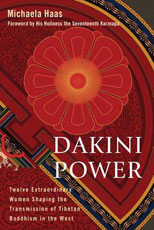"The road to Prajna Mountain Center in one of the wildest parts of New Mexico can be impassable after a rainstorm. Massive potholes open wide beside slippery ruts, causing the vehicle to lurch and heave. lt seemed odd that Roshi Joan would request to be interviewed at 'the refuge,' as it is known, instead of at her Zen center just five minutes from downtown Santa Fe. Was this a kind of trial, a koan about a treacherous path to the master's mountain cave?
"It did make sense, though, that a woman who had once driven a VW van by herself across the Sahara would ask a visitor to make this trek. A woman who, at age sixty-five, had snow-shoed through a blizzard in the dark for four hours to reach the refuge. A woman who in March 2008 had hiked around China and Japan, in the footsteps of Dogen Zenji, on a foot she didn't realize was broken.
" 'She's the most fearless person I've ever met,' said Peg Murray, her assistant, who graciously offered a ride up the road in Roshi's Toyota 4Runner. Navigating the deep ruts with ease, Murray talked about the first time she had made the drive. Roshi Joan was her passenger, and the spring run-off had dissolved the road to slippery clay muck. Deprived of traction, the knobby wheels slid across the surface as if it were ice. Every time Roshi got out to assess their predicament, she sank up to midshin in mud. 'I wanted to turn back,' Murray said. 'But Roshi wouldn't let me. She just kept saying, "You can do this!" She even offered to take the wheel.'
"Known for embracing challenging, even risky situations, Roshi explained, 'Inside me there's this incredible optimist.' Roshi's longtime student and colleague Maia Duerr, however, has a somewhat different take. 'I think the key to understanding Roshi Joan is seeing her fragility as well as her fearlessness. She is literally fragile right now, her bones breaking. Her mind is brilliant and her heart is huge, but her body is at the breaking point. She has pushed herself to exhaustion.'
"Fearless, fierce, and fragile: core aspects of a complex woman who is also an academic and an activist, a wild child of the sixties and a celibate priest. Roshi Joan is witty, irreverent, bold, mercurial, sometimes difficult, driven by aspiration and tamed by discipline. You'll catch her without her BlackBerry, iPad, and MacBook Pro — tools of building institutions — only on mountain trails and in the meditation hall. But she is best known for sitting at the bedside of terminally ill patients and pioneering a form of contemplative care. Her 2008 book, Being with Dying: Cultivating Compassion and Fearlessness in the Presence of Death, synthesizes lessons from her four decades as a leader in the field. After the accident, this longtime caregiver had to learn how to be, as she put it, 'a better care receiver.'
"At the refuge, it became clear why Roshi Joan had insisted on this venue. Among Prajna's tangle of wildflowers and groves of giant aspens, she was more spacious, at ease. Roshi was reclining beside a plate-glass window, her back propped up by meditation cushions, laptop on lap. Her freshly shaved head accentuated her high cheekbones, her blue eyes flashed with intensity and humor. She spoke about her life's work and about where she was and who she was at that pivotal time while her body forced her to pause.
" 'I'm a kind of "plain rice" Buddhist,' Roshi Joan said. She described 'plain rice' Buddhism as the meditation of everyday life. 'When it's time to meditate, you meditate, and when it's time to make a bed, you make a bed. Not very exciting but, actually, exciting. The fierce kind of excitement. Excitement without excitation. It's about being alive.' "
